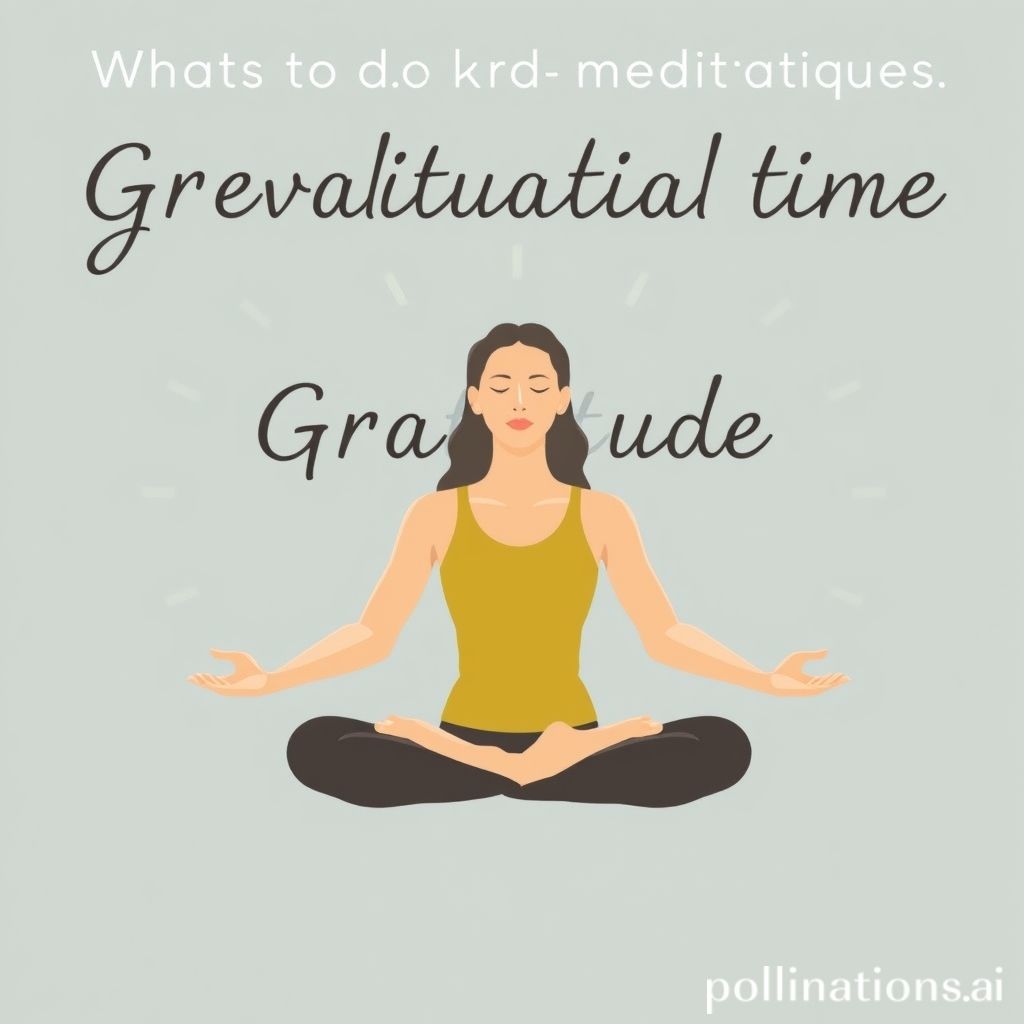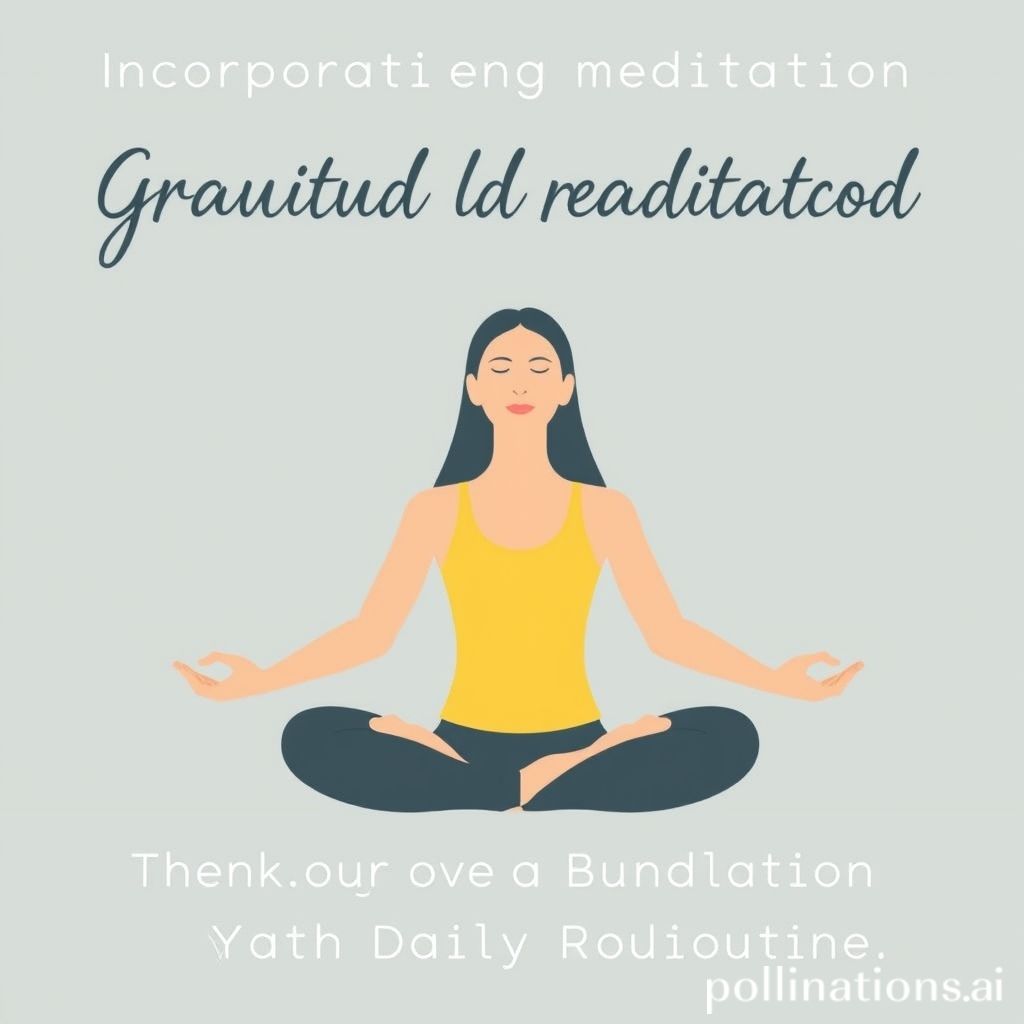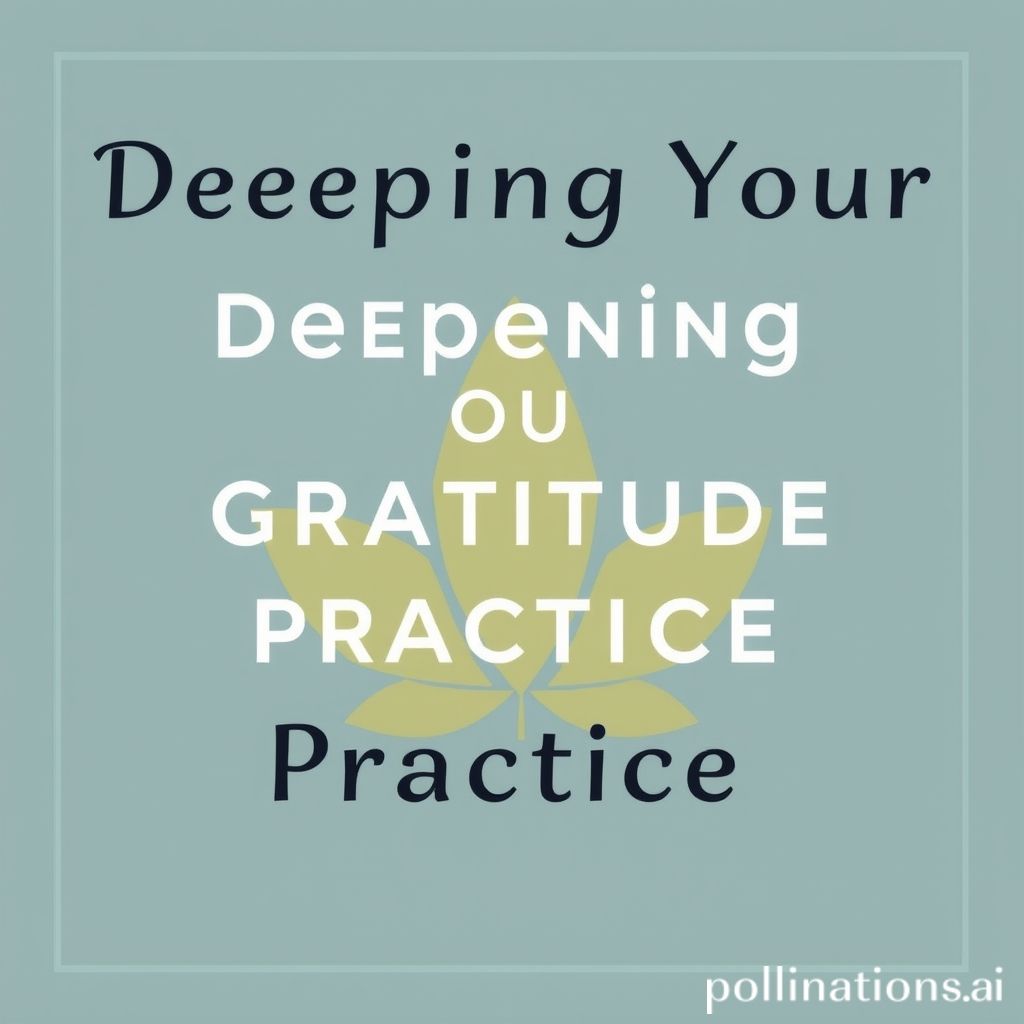Gratitude meditation is a practice that involves focusing on the things we are thankful for in our lives. It is a simple yet powerful technique that can help us cultivate a positive mindset and improve our overall well-being.
By taking a few minutes each day to reflect on the things we appreciate, we can reduce stress, increase happiness, and improve our relationships with others. In this article, we will pioneer some effective gratitude meditation techniques that you can incorporate into your daily routine.
Discerning the Basics of Gratitude Meditation
Gratitude meditation is a powerful practice that can bring about a profound shift in our mindset and overall well-being. By cultivating a gratitude mindset, we can learn to appreciate the simple joys and blessings in our lives, leading to increased happiness and contentment.
1. How to Cultivate a Gratitude Mindset
Cultivating a gratitude mindset involves consciously focusing on the positive aspects of our lives and articulating gratitude for them. It begins by acknowledging the things we are grateful for, whether big or small. This could be the love and support of our family and friends, the beauty of nature, or even the simple pleasure of a warm cup of coffee in the morning.
One effective technique is to create a gratitude list or practice gratitude journaling. By writing down the things we are grateful for each day, we train our minds to seek out and appreciate the positive aspects of our lives.
Another helpful practice is to express gratitude to others. Taking the time to thank someone for their kindness or help not only strengthens our relationships but also increases our own feelings of gratitude.
2. Finding Gratitude in Everyday Life
Finding gratitude in everyday life is about shifting our focus from what is lacking to what we already have. It involves paying attention to the present moment and finding joy in the little things.
For example, instead of dwelling on a long commute to work, we can practice gratitude by appreciating the beautiful scenery along the way or enjoying the opportunity to listen to our favorite podcast.
Practicing mindfulness can also help us find gratitude in everyday life. By staying present and fully engaging in our activities, we become more aware of the beauty and blessings that surround us.
3. Keeping a Gratitude Journal
A gratitude journal is a powerful tool for cultivating gratitude. By regularly writing down the things we are grateful for, we create a record of the positive aspects of our lives that we can look back on during challenging times.
To keep a gratitude journal, simply set aside a few minutes each day to reflect on the things you are grateful for. Write them down in your journal, being as specific as possible. For example, instead of simply writing “I’m grateful for my family,” you can write “I’m grateful for the love and support my family provides.”
| Benefits of Gratitude Meditation | Scientific Research |
|---|---|
| 1. Increased Happiness: Gratitude meditation has been shown to increase feelings of happiness and life satisfaction. | 1. Study by Emmons and McCullough: Researchers Emmons and McCullough found that participants who practiced gratitude meditation experienced greater levels of happiness and well-being. |
| 2. Improved Relationships: Conveying gratitude to others can strengthen relationships and foster a sense of connection. | 2. Study by Algoe et al.: Algoe et al. conducted a study that showed manifesting gratitude towards a partner led to increased relationship satisfaction. |
| 3. Reduced Stress: Gratitude meditation has been found to reduce stress levels and promote relaxation. | 3. Study by Kini et al.: Kini et al. conducted a study that demonstrated the stress-reducing effects of gratitude meditation. |

Different Techniques for Gratitude Meditation
Gratitude meditation is a powerful practice that can help you cultivate a sense of appreciation and positivity in your life. There are various techniques you can use to elevate your gratitude meditation practice:
1. Guided Gratitude Meditation
One effective technique is to engage in guided gratitude meditation. This involves listening to a recorded meditation that guides you through representing gratitude for different aspects of your life. You can focus on specific people, experiences, or things that you are grateful for, allowing yourself to fully immerse in the feelings of appreciation.
2. Visualization Exercises for Gratitude
Visualization exercises can also be incorporated into your gratitude meditation practice. Close your eyes and visualize yourself in a peaceful and serene setting. Imagine that you are surrounded by everything you are grateful for. Visualize the details and sensations associated with these blessings, allowing yourself to fully experience the gratitude they bring.
3. Using Affirmations in Your Gratitude Practice
Affirmations are positive statements that can help shift your mindset towards gratitude. Incorporate affirmations into your gratitude meditation practice by repeating phrases such as “I am grateful for all the abundance in my life” or “I appreciate the simple joys that surround me.” By affirming these statements, you reinforce the feelings of gratitude and attract more positivity into your life.
| Technique | Description |
|---|---|
| Guided Gratitude Meditation | A recorded meditation that guides you through communicating gratitude for different aspects of your life. |
| Visualization Exercises for Gratitude | Closing your eyes and visualizing yourself in a peaceful setting, surrounded by everything you are grateful for. |
| Using Affirmations in Your Gratitude Practice | Repeating positive statements that reinforce feelings of gratitude and attract more positivity into your life. |
Embedding Gratitude Meditation into Your Daily Routine
Gratitude meditation is a powerful practice that can bring about positive changes in your daily life. By focusing on gratitude, you can cultivate a sense of appreciation and contentment. Here are some tips on how to incorporate gratitude meditation into your daily routine:
1. Creating a Gratitude Ritual
Start by setting aside a specific time each day for your gratitude meditation practice. This could be in the morning when you wake up, during a break in your workday, or before you go to bed. Find a quiet and comfortable space where you can sit or lie down without distractions. Begin by taking a few deep breaths to center yourself.
- Reflect on the things you are grateful for in your life. It could be as simple as a beautiful sunset, a loving relationship, or good health.
- Express your gratitude internally or externally. You can silently repeat grateful affirmations or write them down in a gratitude journal.
- Visualize the feeling of gratitude spreading throughout your body and radiating out into the world.
2. Finding the Right Time and Place for Meditation
Choose a time and place where you can relax and focus without interruptions. It could be a quiet corner in your home, a peaceful park, or even your office during a lunch break. Make sure you have a comfortable seating arrangement and eliminate any distractions, such as turning off your phone or closing unnecessary tabs on your computer.
3. Combining Gratitude Meditation with Other Mindfulness Practices
Gratitude meditation can be enhanced by encompassing other mindfulness practices into your routine. Consider combining it with:
- Mindful breathing: Focus on your breath as you inhale and exhale, being fully present in the moment.
- Body scan meditation: Bring your attention to each part of your body, noticing any sensations or areas of tension.
- Loving-kindness meditation: Send feelings of love, compassion, and well-wishes to yourself and others.

Deepening Your Gratitude Practice
In this section, we will traverse ways to augment and deepen your gratitude practice. Gratitude is a powerful emotion that can bring joy and positivity into your life. By manifesting gratitude to others, practicing self-gratitude, and cultivating gratitude in challenging times, you can experience the full benefits of a gratitude practice.
1. Articulating Gratitude to Others
Communicating gratitude to others is a wonderful way to strengthen your relationships and spread positivity. Take the time to acknowledge and appreciate the people in your life who have made a positive impact. You can write a heartfelt thank-you note, send a thoughtful gift, or simply express your gratitude in person. By showing gratitude to others, you not only make them feel valued but also cultivate a sense of gratitude within yourself.
2. Practicing Self-Gratitude
Practicing self-gratitude is just as important as articulating gratitude to others. Take a moment each day to reflect on your own accomplishments, strengths, and blessings. Write down three things you are grateful for about yourself and why. This exercise can help boost your self-esteem, improve your mood, and foster a greater sense of self-worth. Remember to be kind to yourself and appreciate the unique qualities that make you who you are.
3. Cultivating Gratitude in Challenging Times
During challenging times, it can be difficult to maintain a gratitude practice. Nevertheless, cultivating gratitude during these times is even more important. Look for the silver linings and lessons in adversity. Practice reframing negative situations and finding gratitude in the midst of hardship. This can help shift your perspective and bring about a sense of resilience and hope. Remember that gratitude is a choice, and even in difficult times, there is always something to be grateful for.
| Topic | Info/Data |
|---|---|
| Manifesting Gratitude to Others | Strengthen relationships, spread positivity |
| Practicing Self-Gratitude | Boost self-esteem, improve mood |
| Cultivating Gratitude in Challenging Times | Find silver linings, foster resilience |

The Science behind Gratitude Meditation
In this section, we will investigate the fascinating science behind gratitude meditation and its numerous benefits. Gratitude meditation is a powerful practice that has been extensively studied by researchers. Let’s venture into the research studies that have investigated the effects of gratitude.
1. Research Studies on the Effects of Gratitude
Multiple research studies have examined the impact of gratitude on various aspects of our lives. These studies have consistently shown that practicing gratitude can have profound effects on our mental and emotional well-being. For example, a study conducted by Dr. Robert A. Emmons and Dr. Michael E. McCullough found that individuals who regularly practiced gratitude experienced increased levels of happiness and overall life satisfaction.
Another study published in the Journal of Personality and Social Psychology revealed that gratitude exercises can improve sleep quality and reduce symptoms of anxiety and depression. These findings highlight the therapeutic potential of gratitude meditation.
2. How Gratitude Rewires the Brain
Gratitude meditation has been found to have a transformative effect on the brain. Neuroscientists have discovered that practicing gratitude can actually rewire neural pathways, leading to long-lasting changes in brain structure and function.
Research has shown that gratitude activates the brain’s reward system, releasing dopamine and other feel-good neurotransmitters. This not only enhances our mood but also strengthens neural connections associated with positive emotions and well-being. By regularly practicing gratitude, we can train our brains to become more positive and resilient.
3. The Relationship between Gratitude and Well-being
Numerous studies have established a strong correlation between gratitude and overall well-being. Grateful individuals tend to experience higher levels of life satisfaction, optimism, and resilience. They also have lower levels of stress, anxiety, and depression.
Furthermore, research has shown that gratitude can improve relationships and social connections. Representing gratitude towards others fosters a sense of appreciation and strengthens bonds. It promotes empathy, compassion, and forgiveness, creating a positive and nurturing social environment.
To provide you with a comprehensive comprehending of the topic, we have included an informational table below, summarizing key research findings related to gratitude meditation.
| Research Finding | Description |
|---|---|
| Increased Happiness | Regular gratitude practice leads to higher levels of happiness and life satisfaction. |
| Improved Sleep Quality | Gratitude exercises can elevate sleep quality and reduce insomnia symptoms. |
| Reduced Anxiety and Depression | Practicing gratitude has been shown to alleviate symptoms of anxiety and depression. |
| Enhanced Social Relationships | Communicating gratitude strengthens social connections and fosters empathy and forgiveness. |
Read More:
1. Balance Within: Chakra Balancing with Gratitude
2. Emotional Harmony: Gratitude for Wellness